Every day, we go through tons of different emotions, but the fact of the matter is that humans are only capable of feeling four basic four “basic” emotions, which are, afraid/surprised, happy, sad, and angry/disgusted. But from those four basic emotions, there is a whole spectrum of emotions that we can feel, similar to how there are only three basic colors, which in turn can be mixed to create secondary colors.
While we like to believe we are rational creatures who make clever, logical, and well-thought decisions based on deep thought and consideration, but in reality, humans make emotional decisions.
The neuroscientist Antonio Damasio made a study on individuals who had damaged the part of the brain where emotions are generated, and the findings were groundbreaking. The individuals he studied were completely normal, despite their small brain damage, however, they all had something in common, and that was that they couldn’t make decisions.
Logically, the individuals were able to describe what they should be doing, however, they still had a very hard making decisions – even for the most simple things. His revolutionizing study could draw the conclusion that humans make decisions based on our emotions, not based on logical thinking as we might want to believe.
And in marketing, this is something tremendously valuable, as you can imagine. this means that the way to convince people to buy from you isn’t by presenting them with facts that show them why really, there isn’t any better alternative than you, but more so, it’s about impacting your audience emotionally. This means that by understanding how the emotions of humans work, and what effect they have on us humans, we can leverage it, and create marketing campaigns which focus on impacting our audience emotionally, so they make the decision to buy from you.
Getting someone to buy from you means getting them to make the decision to buy from you. And when you realize that their decision to buy from you is based on emotions, the whole script flips.
In this article, we’ll, therefore, look at how the emotions of humans work, but more importantly, look how you can leverage the power of emotions in your marketing.
Understanding the power of emotions in marketing
Now that we know that it isn’t the rational thinking that we make our decisions based on, we can extend that thought to all aspects of marketing and advertising. This means that it isn’t the content in the ad itself that convinces us to buy, but it is the emotions that the ad evokes.
And when a study then found that the most-shared ads of 2015 are all heavily related to things that evoke emotions, whether it be love, happiness, relationships, etc., we aren’t very surprised.
While many marketers have realized this, far from everyone has, and this is why you need to implement emotions in your marketing strategy.
The Psychologist Robert Plutchik identified eight primary emotions, and at first, it might be a bit contradictive to what I first mentioned with four basic emotions, but what Plutchik did was he also added the opposites of each emotion, for instance, joy and sadness. Below, you can find the so-called wheel of emotions which shows the spectrum of emotions that we humans can feel.
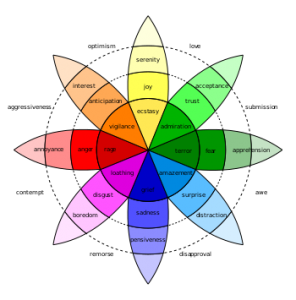
Emotional branding
When talking about emotions in marketing, it’s hard not to mention emotional branding, because essentially, it is what lays the foundation for this complete area.
Wikipedia describes emotional branding as ”a term used within marketing communication that refers to the practice of building brands that appeal directly to a consumer’s emotional state, needs, and aspirations.”
While marketing is more about acquiring new customers, branding is more about how you portray your brand and get your customers to view your brand.
When you work with emotional branding, you focus more on building relationships with your customers and getting them to view you and remember you in a certain way.
And the best part about doing so is that you, in the long run, can have a significant impact on your audience – just by the way your brand is perceived.
Why?
Because emotional branding creates a feeling of bonding, companionship, or even love with a brand. In that way, emotional branding is more about how you get your audience to resonate emotionally with your brand rather than individual campaigns.
It is with emotional branding that you have the opportunity to set your brand apart from your competitors and become unique.
All of the top brands that you know today have greatly emphasized emotional branding, making them so much more than just a brand, but a brand in which people have an emotional connection with.
When working with emotional branding, you, therefore, want to think about the emotion you want to evoke in your customers, and the emotion you want in their target audience when they think about your brand. If you take Apple, for example, you probably think about them in a certain way, and maybe you remember that sense of exclusivity when opening the box of your new iPhone.
And with the help of Apple’s emotional branding, they can get their customers to buy more, as customers resonate with them emotionally, and emotions being what convinces people to make decisions – including those to buy.
Probably the most effective emotion in Apple’s branding strategy is the sense of belonging and being part of a group. This emotion is one that is incredibly powerful, considering it has, in the human history, been crucial to be a part of a group in order to survive. And if we were excluded from the group, the chance of surviving would be minimal. Humans feel a great need to be a part of something that’s greater than ourselves – something big and important, and this sense of belonging is something that follows us through our entire life, whether it be cheering on a particular football team, supporting a particular party, or, even being part of a club of some sort.
Now, let’s dig into the many ways you can leverage emotions in your marketing to get your customers to make the decision to buy from you.
The emotional power of storytelling
You are probably not unfamiliar with the fact that storytelling is tremendously effective in marketing.
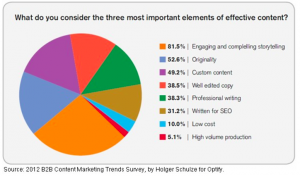
In fact, chances are, you’ve been using it in your marketing.
But have you ever reflected on what it is that makes storytelling in marketing so effective?
The answer is emotions.
Because when you use storytelling, you engage your customer and create an emotional connection between your customer and your brand, by telling them a story which they relate to. As a result, you make your brand so much more than just a logo and brand name, but you make it something which your customers have a deeper relationship with.
In fact, an experiment was made where spoons were put up for sale on eBay, including a brief description. The average value of a customer was then $42.83, but then, they mixed up the product page by adding a story by award-winning poet Mark Doty, and then, the value reached $70.03.
This goes to show how storytelling leads to customers better resonating with brands and products if a story is included, and how ultimately, it can get them to spend more.
Emotional storytelling also has a great effect on how likely we are to remember the message of the brand. Few people can recall an ad from a brand, but humans have a lot easier remembering a story – especially one that has impacted us emotionally. Amanda D’Annucci, in ”Storytelling, Psychology and Neuroscience” showed that storytelling engages people and their whole brains, including the memory center in the brain. As a result, storytelling does not only make people resonate with brands and campaigns emotionally, but they also make us much more likely to remember the brand as a result of the story.
The place where storytelling can be seen the most is on landing pages and product pages. And that’s not very surprising really, considering that they are places where the customers have landed when they’ve traveled a bit down the sales funnel, and now, it is time to make them convert.
And what storytelling these places allow you to do is instead of going on and on about all the benefits of your products, and all the reasons in the world they should buy from you, hoping that they’ll make a decision rationally (which they won’t), you can instead leverage storytelling and engage and impact your audience on a much deeper level.
Emotions in marketing: build trust
Having trust as a brand is crucial for success, but at the same time, gaining trust from your customers is extremely difficult.
The reason trust is so important as a brand is that unless your customers don’t trust you, they won’t buy from you.
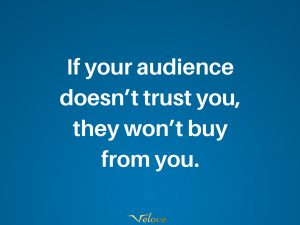
But at the same time, everyone knows that brands have one goal and one goal only, and that goal is to sell more.
This has led to people being skeptical to what brands are saying, as people know that everything the brand says is said to support them in their goal of selling.
And this is where a conflict is met between the importance of having your customers trust you in order to get them to buy from you, but also getting them to buy from you, without coming off as untrustworthy.
The good news, however, is that you can increase the trust people have in you by leveraging emotions, because the truth is, trust is based on emotions – the emotions we feel towards a brand, and if those emotional instincts tell us we can trust a brand or an individual.
There are many strategies you can use to increase your trust, but the most fundamental is that you provide your customers with value. And the thing is, it doesn’t have to be an actual, monetary value, but you need to provide them with perceived value. If you provide your customers with things that they perceive as valuable, that’s when you’re on the right track.
Trust is only built through relationships, and relationships are built from constant interactions, and the most interesting part about this is that it gets clear that the relationships have to be give-take relationships. Relationships, where only one side is benefiting from the relationship, is never sustainable, and this ties together what I said earlier about the importance of providing value to your audience.
When doing so it is important that you provide value without expecting. If you’re giving by expecting, it becomes inauthentic, and you come off as untrustworthy.
One of the parts of doing this is having a value proposition. If you don’t have a value proposition, create one, and clearly present it.
Emotions in marketing: happiness and shares
As I spoke about briefly earlier, all of the most shared ads in 2015 were ads that had incorporated emotions in one way or another.
As a result, you can understand the importance of creating ads that play on emotions if you want them to gain traction with the help of your audience.
Joy and happiness have proven to be among the emotions that drive actions the best. This is especially effective for getting shares because humans perceive shared joy as the best joy, and this is also the reason why we often laugh a lot more when we are with other people.
When you create a piece of content that is based on happiness, people are therefore more likely to share it.
Not only were the most shared ads in 2015 based on happiness and joy, but in a study which analysed nearly 7,000 articles in The New York Times, it was also found that He found that articles are more likely to become viral the more positive it was, and that does perhaps not come as a surprise with everything I’ve spoken about in mind.
There’s a reason why videos like the one below gains immense traction and a ton of shares.
While it isn’t a video that necessarily makes us laugh, it makes people say ”awww”, and it impacts us on a deep level emotionally.
And with the end being a positive one, the video ends on a good note, possibly even making some people shed a tear.
Emotions in marketing: leverage sadness for compassion
Sadness is an emotion you can leverage in your marketing to get your audience to have compassion with something, to resonate, and have empathy.
The brands you see using this the most are brands like WWF, UNICEF, and other brands working with charity.
For many, something that’s happening many thousand miles from us can be hard to take in, and it can feel distant from use, and therefore, they often create videos that evoke sadness, which is made to evoke compassion, which in turn should lead to us taking an action, such as donating money.
While charities are often the brands that leverage sadness in their marketing the most, regular can leverage it too, to increase sales, and the fact is that many have!
The best part about this is that you get your audience to resonate with you on a deeper level, leading to connection and empathy. When the emotion sadness is evoked in us, the chemical oxytocin is released in our brain, and a study found that the individuals whose brains produced the highest level of oxytocin were also the individuals who were most likely to give money to people they couldn’t see – something that charities are often heavily dependent on.
Moreover, this is also the reason to why Budweiser’s ”Stand by me” commercial was so successful:
https://www.youtube.com/watch?v=CxGUmtRLm5g
It sparked sadness in the viewers, but it also allowed the brand to show their human side at the same time.
And for Budweiser, this was an incredibly clever move, because sadness makes us resonate and have empathy, and when the brand at the same time shows their personal side, a side with emotions, it makes people resonate with the brand, and build trust in the brand.
And as you know by now, relationships lead to sales.
Emotions in marketing: Positivity for credibility
We’re a lot more likely to trust someone who is smiling than someone who looks angry, right?
If we’re standing in a room full of strangers, we’re also more likely to approach someone who is smiling, rather than someone who is looking angry, right?
By being positive and sharing emotions, you make yourself much more approachable, and this is the first step to building customer relationships.
Chances are, you’ve seen a lot of landing pages and ads where you can see a person smiling.
Like this landing page by Kissmetrics:
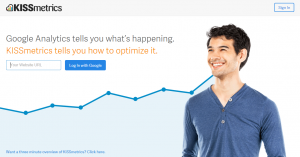
And the reason is that there is evidence that when brands showcase people, especially when smiling, they evoke a sense of trustworthiness, thus making the people more likely to trust your brand. Moreover, smiling faces, for instance on your landing page, has actually proven to increase conversions, and that is not very surprising when you know that positivity makes your brand more trustworthy.
Studies have found that our brains are wired to react positively to when someone else is smiling, and apart from just making you more trustworthy, showcasing a person smiling in your marketing will, therefore, give your audience a positive experience of your brand, and therefore result in them leaving with a positive memory of your brand.
When we are happy and smile, the brain releases hormones such as serotonin, endorphins, and dopamine, which all contribute to us remembering the brand experience as a highly positive one.
In fact, there’s a reason that the vast majority of marketing videos you see from brands are focused on evoking positive emotions.
What having a real person smiling does is it increases your brand’s credibility because it shows that you aren’t hiding behind your fancy logo and fancy brand, but more so standing proudly in front of it. Moreover, humans obviously also help humanize your brand, something that is always helpful when you want to build better relationships with your audience.
There are obviously tons of ways you can implement positivity in your marketing apart from having someone smiling in your campaign, but what’s important is that you aware of the many positive impacts (see what I did there?) it has on your audience which will benefit you as a brand.
Emotions in marketing: Fear
Fear is a tremendously effective emotion in marketing, and it is probably used more than you realize.
But in marketing, fear isn’t used in the same way as people who go around propagating the end of the world are using it. Instead, fear is used a little bit differently in marketing.
And most often, it is the fear of missing out that is leveraged.
Fear of missing out, or FOMO, is an emotion that all humans have proven to have – to a smaller or greater degree.

Humans are wired to protect themselves to dangers, and the human brain is also programmed in the way that it constantly looks for fears, and then gets you to act in a way that protects you from them. In other words, it is a very clever defense mechanism that we humans have that have saved many lives, especially when we were living as nomads when dangers were never far away.
The marketing messages that leverage fear have shown to be very effective, and that’s not a coincidence. It is because the fear makes us humans act quickly in order to extinguish the danger as soon as possible. So if you can create this sense of danger in your marketing, without creating a threat (doing so can instead backlash and harm your brand), you’ll be able to get your customers to act emotionally, thus meaning very quickly and instantly, without thinking twice.
When our brain notices a danger, it sparks fear in us, and this is done by the brain activating the amygdala which creates a need instead of a want for your product. And this is the leverage you want to have when you sell because it’s a lot easier to sell something when people have a need for something rather than just wanting it.
Why? Because when we want something, we want it now.
Also known as instant gratification.
It’s quite interesting how leveraging the emotion of fear in marketing works because you as a brand are the one that creates the danger, which in turn sparks fear, and then, you are the one that provides the solution, the thing that will remove the fear. A very clever strategy if you think about it.
Moreover, another interesting marketing benefit of the emotion fear is that humans often want to share fear with someone else consumers who experienced fear, and if we are sensing fear, for instance by watching a promotional video, it can lead us to feel a greater connection to the brand since your brand is closest at hand.
In other words, by leveraging fear in marketing, you can actually improve your customer relationships and get them more engaged in your brand.
The most common type of FOMO, or Fear of Missing out, is when an offer is only available for a limited amount of time, or when there are only a few products left.
This promotion campaign by Edith & Ella doesn’t showcase how many products are left or how long time there is left, instead, they explicitly write ”Don’t miss out”. This leaves much room for imagination, and encourages their audience to act fast because who knows when the opportunity might be gone?
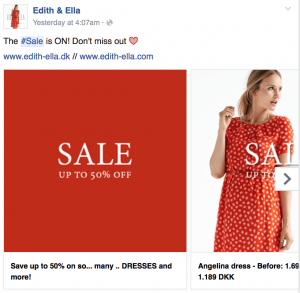
Spark Anger
As a brand, making your audience angry can be a bit risky, because if done in the wrong way, it might backlash.
This is also why many brands stay away from it.
But with great risk come high reward, and if you can successfully run a marketing campaign that is focused on anger, you can gain tremendous success.
Because the truth is that anger doesn’t always lead to aggression because a study also found that anger can create curious stubbornness a recent University of Wisconsin study
And you might recognize yourself in that. Maybe you’ve played a game and got stuck at a level. Each new try you make, you become angrier, but you keep on trying.
When humans are angry we tend to do things. And those actions are made because we want the anger to go away, or at least decrease.
And as a brand, your ultimate goal is based on your audience doing something, in most cases, buying from you.
This would mean that by leveraging the power of anger, you can get more of your customers to buy from you. But how do you do it, in practice?
One way, which is also the most common way, is to leverage your marketing to greatly emphasize a big problem that creates a lot of anger in your audience. And fortunately, this is a problem which your brand solves.
Since visual content is so effective, and storytelling equally so, creating a video is most often the best way to get your audience to resonate with your story.
As an example, let’s say that your brand sells some kind of entertainment program that helps make the time you spend in traffic jams a bit more pleasant. With your video, you can emphasize the anger that a person is feeling by sitting countless of hours in a traffic jam, and then, you present the solution to this by showing how your product decreases that anger.
The people who have some time sitting in a traffic jam will then resonate with your video and start feeling the feeling they feel every time it happens, and thus, that anger will lead to them buying from you.
If you want your audience to do something, you need to create that sense of angry which you know your brand solves.
Emotions in marketing: create a sense of belonging
As I’ve touched upon earlier, humans have an inner need to be a part of a group which is rooted in our survival instinct – an instinct that is many thousand years old. There are lots of brands who leverage this, and they do so in a number of different ways.
One of those ways is social proof.
Chances are, you’ve been looking at social proof before you have bought something online.
And I say this because 70 percent of customers report that they look at product reviews before making a purchase. And this is not so strange because social proof is also 12x more trusted than product descriptions from brands themselves.
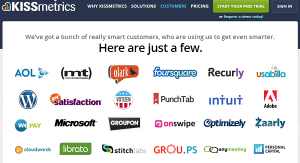
Review sites like Yelp and TripAdvisor have grown to the sheer size they are today because humans are emotionally impacted what their peers are saying about a brand. And since reviews are so trustworthy, it also makes the review sites tremendously powerful.
Maybe you’ve seen restaurants that have a sticker on their door saying ”top rated restaurant on TripAdvisor”, or ”5000 people love our restaurant”, and this is one way that brands understand (and leverage) the power of social proof, and more importantly the emotion of belonging.
It’s not uncommon that brands use quotes like ”trusted by millions” in their marketing, because not only do you not want to miss out (FOMO – what is it that others have that I don’t), you also want to be a part of a larger group.
What brands are essentially saying when they use social proof in their marketing is ”Tons of people trust us, so you should too”. The social proof gives us validation and increases our trust in brands, making them more credible. When we read other customers’ reviews, we tend to put ourselves in their shoes, and this leads to us being more emotionally impacted, too.
Remember that we buy based on our emotional wants, and if you can show people that if they buy your product, they become part of a group, a community, people will be much more likely to buy from you.
For example, if you are among a group of people, a community, who all have the same brands on their jacket, you’ll be much more likely to buy that jacket. Not necessarily because it is the most beautiful jacket, but because of how that jacket allows you to be a part of a community and a group of people. In other words, how the jacket makes you feel.
This is why it is so important to emphasize the emotions that the jacket brings, not mainly all the benefits of the jacket unless you’re playing on the strategy to create a sense of exclusivity and uniqueness.
Wrapping it up
It’s safe to say that emotions in marketing are tremendously important for success.
Many marketers are trying to present the amazing benefits of their products, and thus convince their customers with reasonable and logical thinking, but those who do aren’t aware of the fact that humans are irrational creatures who actually makes decisions based on how we are feeling.
In a study which included 1,400 cases of marketing campaigns that had been successful, it was proven that marketing campaigns that were solely focused on emotions performed almost twice as well as those that mixed rational thinking and emotions. about twice as well. And when you know that humans make decisions with their emotions, it’s not that strange, really.
The bottom line is therefore that you need to make emotions in marketing a central part of your marketing strategy because, in reality, that’s how you convince your customers to make the decision of buying from you.


